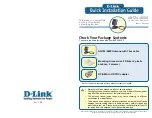
Troubleshooting and Maintenance
DTV04 HD TVRO Antenna
7-2
1.
Radome Inspection - The radome top/bottom flanges are properly sealed to prevent wind,
saltwater spray and rain from being able to enter the radome. Re-seal any open (“leaky”)
areas with marine approved silicone sealant. If heavy condensation, or standing water, is
found inside the radome, isolate and seal the source of the leak, and then dry out the
radome. Small (1/8 inch) holes may be drilled in the recesses of the base pan of the
radome to allow standing water to “weep” out.
2.
Antenna Pedestal Inspection - The springs (or rubber vibration dampeners) should not be
completely compressed, or otherwise damaged. The plated and painted parts should not
be rusted or corroded. The harnesses should not be frayed and all the connectors should
be properly fastened and tightened. All hardware should be tight (no loose assemblies or
counter-weights). Replace, re-coat, repair and/or tighten as necessary.
7.2.7.
Turn the antenna control unit OFF
Mechanical Checks
1.
Inspect inside of radome for signs that the dish or feed have been rubbing against the inside of the
fiberglass radome.
2.
Rotate the pedestal through its full range of azimuth motion. The antenna should rotate freely and
easily with light finger pressure.
3.
Rotate the pedestal through full range of elevation rotation. The antenna should rotate freely and
easily with light finger pressure.
4.
Tilt the pedestal through full range of left-right cross-level rotation. The antenna should rotate
freely and easily with light finger pressure.
5.
Rotate the level cage through the full 90 degrees of rotation from CCW stop to CW stop.
6.
Inspect all drive belts for wear (black dust on/under the area of the belt).
7.2.8.
Check the balance of the antenna, re-balance as needed (refer to the Balancing the Antenna procedure
below).
Check Balance
7.2.9.
Observe the Antenna Initialization as described in the Troubleshooting section below.
Observe Antenna Initialization
7.2.10.
Assure that the parameters are set correctly (you may wish to record them in the Factory Default Settings, in
section 5 of this manual).
Check ACU Parameters
7.3.
Troubleshooting
Below are theory and diagnostic tests to assist you with troubleshooting the antenna. Refer to the previous
section to check settings and do some initial functional testing prior to beginning troubleshooting.
7.3.1.
The antenna system is mounted on a three axis stabilization assembly that provides free motion
with 3 degrees of freedom. This assembly allows the inertia of the antenna system to hold the
antenna pointed motionless in inertial space while the ship rolls, pitches and yaws beneath the
assembly. Three low friction torque motors attached to each of the three free axes of the assembly
provide the required force to overcome the disturbing torque imposed on the antenna system by
cable restraints, bearing friction and small air currents within the radome. These motors are also
used to re-position the antenna in azimuth and elevation.
Theory Of Stabilization Operation
Содержание DTV04
Страница 3: ......
Страница 4: ...iv Revision History REV ECO Date Description By A N A April 23 2009 Initial Release ECM ...
Страница 22: ...Installation DTV04 HD TVRO Antenna 4 4 This Page Intentionally Left Blank ...
Страница 30: ...Setup DTV04 HD TVRO Antenna 5 8 THIS PAGE INTENTIONNALY LEFT BLANK ...
Страница 50: ...Troubleshooting and Maintenance DTV04 HD TVRO Antenna 7 18 THIS PAGE INTENTIONNALY LEFT BLANK ...
Страница 54: ...Specifications DTV04 HD TVRO Antenna 8 4 This Page Intentionally Left Blank ...
Страница 56: ...Drawings DTV04 HD TVRO Antenna 9 2 This Page Intentionally Left Blank ...
Страница 58: ......
Страница 64: ......
Страница 65: ......
Страница 66: ......
Страница 67: ......
Страница 68: ......















































